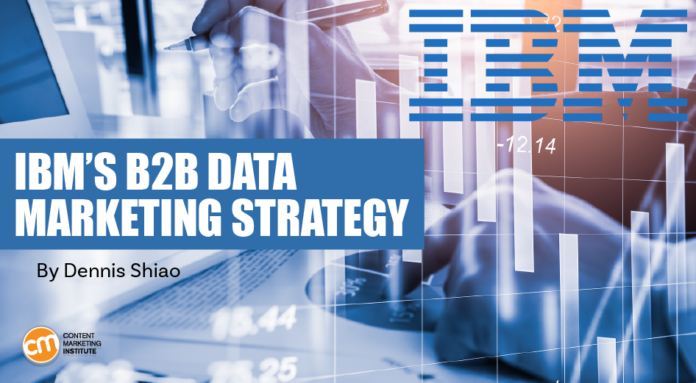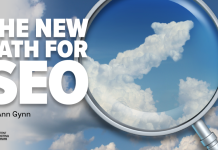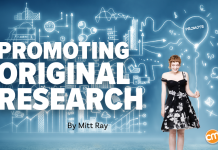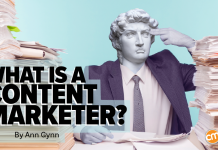My neighbor was a mathematics professor at a college in San Francisco. He once told me, “The longest route between two points is through a committee.”
His quote applies well to B2B sales. A Forrester survey found that 80% of respondents say there are at least three people involved in the buying process, and most of the other 20% say they buy in teams of two.
Caitlyn Wood, senior data scientist at IBM, says shifting your B2B marketing strategy from targeting individuals to focusing on the account level is a must.
During her talk at the Marketing Analytics & Data Science (MADS) conference, Caitlyn compares B2B buying to a family buying a home. Although parents are the ultimate decision makers, they are not the only voices in the process. “The teenage daughter might want a bigger bedroom, maybe she wants to live near a playground for her son, or maybe she wants a nice fenced-in yard for the dog,” she explains.
In the B2B environment, the decision makers and the other voices in the buying process have different needs. IT wants a product that meets cybersecurity standards. Engineering wants an API to extend the product and marketing wants the ability to have easy-to-build dashboards.
“In the typical lead-based (marketing) model, you look at individual interactions with people, but in the B2B context you really need to look at the bigger picture of what's going on within an account, and not just these small snippets,” says Caitlyn, who creates data science models for sales and marketing at IBM.
Read on to learn their account-level methodology for revamping your B2B marketing strategy.
Follow a high-intensity account framework
When multiple people in an organization consume your content, you can quantify their interest in your products and services. Caitlyn looks for accounts with multiple marketing interactions within a 30-day period. Depending on your sales cycle, you can use a month or longer, such as 90 or 120 days.
In the IBM sales pipeline, approximately 12% of accounts reach this multi-interaction status each quarter. About eight out of ten accounts involve two or more people, and 87% involve multiple product areas. These accounts are four times more likely to be converted into an opportunity within 30 days.
“We want to learn from the accounts that are consuming our content quickly and converting pretty quickly,” says Caitlyn. “These are the accounts that say, 'I looked at IBM, I really like what you do and I want to buy from you.'”
Once these high-intensity accounts are identified, marketing can invite them to events and encourage them to sign up for free trials or demos. Sales can also prioritize follow-up interactions because these accounts are likely to convert quickly.
The framework also allows marketing to better understand the journey of coveted customers. Caitlyn explains: “We can look at the most likely ways in which our accounts reach high intensity. Are there any sticking points? Can we fix these sticking points? Is this special content really well received by the financial industry in Germany? Can we adapt this content to other industries or other regions?”
Prioritize and highlight patterns for sales teams
Remember the family that bought a house? A real estate agent showed them homes that met the parents' needs and the children's wants — a large second bedroom, a fenced yard and a location near a playground.
In the B2B sector, marketing and sales take on the role of real estate agents and respond to the wishes and needs of different buyers. Caitlyn says the journey could look like this:
- At the beginning of January, the potential buyers looked at a research report.
- Afterwards, some employees of the organization conducted a free trial.
- A C-suite member and others attended an event hosted by the seller.
- In February, other people in the organization conducted another trial.
Given the increase in account activity, marketing and sales teams would evaluate the interactions and adjust their follow-up conversations and activities accordingly.
“It’s not just one person. It’s not just one attempt,” Caitlyn explains. How do these products interact with each other? How do they mesh with each other? What is this account really interested in? And can we design our conversations to best meet their needs?”
Use the data to optimize an impactful journey
Caitlyn's exploration of high-impact account data uncovered interesting patterns that she used to improve the customer journey with IBM.
More than half (54%) of prospects whose first interaction with IBM is a trial followed by reading a research report are identified as high-intensity customers. But only 26% of prospects who take just one test are likely to convert to a high-intensity account. Likewise, prospects who received a research report within a week of a product demo were 3.2x more likely to convert to a high-intensity account.
The data showed Caitlyn that the research report provides important background information and context for the product being tested or demonstrated. Prospects might think, “I tried the product and trial; I kind of get it, but then this research paper comes along and explains all the benefits that I didn’t really see in the study itself.”
Use data science to find more high-intensity accounts
Not only does IBM use the data to maximize the journey of current prospects; It analyzes data to find new accounts that are highly similar to these accounts – also known as lookalike accounts.
The strategy is based on the assumption that low-interaction accounts have not yet reached the content that will move them into the high-intensity zone. The barriers to accessing this content could be as simple as a broken link or failure to publish a research report after a demo, Caitlyn explains.
To find similar accounts, IBM uses “positive-unlabeled learning,” a type of machine learning that uses positive (i.e., high-intensity) accounts with unlabeled accounts. It analyzes the unlabeled accounts (typically low and medium intensity) to determine whether they should be labeled as high intensity.
“We're not trying to predict who will be high intensity yet, but who will look so similar to our high intensity accounts that we think they should behave similarly, and we can encourage them to continue the conversation with us,” Caitlyn explains.
Positive-unlabeled learning uses market activity, third-party industry data, geo/market data, and historical purchasing data in the analysis. According to Caitlyn, it accurately identifies the lower engagement accounts that can be nurtured to high intensity 93% of the time. These lookalike accounts also convert twice as often as average accounts.
Add account lessons to the system
After identifying high-intensity and similar accounts, ensure that account information flows properly into sales and marketing systems. Here's how IBM does it:
The high intensity accounts flow to the sales rep to execute the Salesloft system's inbound action in a cadence for the next best actions, resulting in conversion.
The lookalike account triggers marketing actions that could trigger the outbound Salesloft cadence to encourage additional activity or start the nurture email stream through Marketo. This new activity could convert the lookalike account into a high intensity account. The new high-intensity account is then put through this process.
Ready to focus on account-level insights?
If my neighbor were moving from academia to B2B marketing, he would say something like this: “The path from investigation to closure is through a committee. So identify the stakeholders on this committee and understand what’s important to them.”
In the past, when the chief information security officer of a Fortune 500 company downloaded a white paper, the brand's marketers always thought it was the start of a big sale.
But don't get too excited about a C-suite download. This CISO may have their signature on the order, but likely has a panel of three to ten or more influencers who collectively decide on a vendor and product offering. Just as with parents buying a new home, the interests of the daughter, son and dog are of great importance.
As the IBM journey shared by Caitlyn proves, it's smart to move from individual insights to account-level insights. Use the data obtained from searching for high-intensity accounts to identify new accounts that are likely to move to high-intensity accounts.
Inform the analysts and data scientists in your company about the Marketing Analytics & Data Science conference co-located with Content Marketing World. Register today and save $100 with promo code BLOG100.
HANDPICKED RELATED CONTENT:
Cover image by Joseph Kalinowski/Content Marketing Institute
Create your very own Auto Publish News/Blog Site and Earn Passive Income in Just 4 Easy Steps






![3 Powerful Ways to Use Social Proof in Email Marketing [+13 Examples]](https://blog.5gigbucks.com/wp-content/uploads/2024/03/3-Powerful-Ways-to-Use-Social-Proof-in-Email-Marketing-100x70.png)
